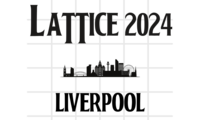Speaker
Description
Transition amplitudes to two-hadron states arise in the interactions between hadrons and electromagnetic and weak currents.
From these transitions, we can study internal charge distributions or rare weak decays of hadrons.
In this talk, we present the first calculation of a transition amplitude to a coupled-channel of two-meson states from first principles.
We extract the timelike form factor of the pion beyond the elastic energy region above the $K\overline{K}$ threshold.
This allows us to compute both the pion and the kaon isovector-vector timelike form factor.
We verify that the extraction of the $\rho$-meson decay constant, from the timelike form factor at the resonance pole, is consistent in both the elastic analysis and the coupled-channel case.
This work lays the foundation to study the internal structure and potentially the nature of resonances that decay into multiple channels, e.g., the exotic $\pi_1$ meson.

